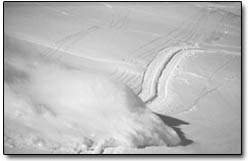
First Turns

Somewhere around my second turn, the fracture ripped
open and the slope exploded. My body weight combined with
more than a couple of Mother Nature’s tricks had
turned the virgin bowl into a trap. Quick looks in either
direction brought about instant realization – I
was about to have my fill of an unwelcome meal.
The avalanche was an effortless and natural progression
– extremely beautiful in a devastating way. But
stuck deep in its middle and beginning to accelerate past
my surroundings, this onlooker’s appreciation was
lost on me. I was far from safety and eager to be elsewhere.
The elsewhere option was clearly not available.
Years of knowing avalanche risk and efforts at past avoidance
seemed meaningless with the event actually under way.
Precaution had failed and the specter was out in the open.
During the course of the slide, my avalanche theory was
replaced by the simplest kind of human struggle, struggle
that was rewarded with continued life.
Regardless, my efforts were relatively meek, and I know
basic luck was mostly responsible for keeping me on top
of the slide. I was outmatched before and during the event.
One has next to no power when riding hundreds of tons
of sliding snow. You can do your best to stay in daylight,
but I highly recommend keeping your fingers crossed as
well.
Once the slide stopped rolling, I had covered close to
200 yards in a few seconds, obliterating the track we
had painstakingly climbed up. Up above, my ski partner
frantically yelled, “Are you OK?” Instead
of answering, I waved my pole. I was alive, but not OK.
The experience shook me to the core.
Ironically, that area in the Anthracites outside Crested
Butte saw incredible traffic on that fateful day. On the
order of 30 cars were parked at the trailhead, and their
occupants were visible on nearly every available north-facing
line. I’d passed hapless others also out for turns,
and jokes about the lack of beacons and shovels abounded.
Looking back, the atmosphere seemed more like a day of
lift-served than a trip into the great beyond. Luckily,
all of us made it, or at least none of us made the papers.
Looking back, I realize that it was high time for an
awakening. My awareness of my place in the mountains had
been dulled, and to be honest, I was getting sloppy. That
day, I hadn’t been tracking weather trends, skipped
snow analysis and ignored obvious signs of instability.
Having tasted the force of avalanche, my backcountry
ethic came around immediately. I still love skiing backcountry
powder, but now I do it tentatively. I’ve even done
the unthinkable and turned around after several hours
of uphill struggle. I’m in no way eager to be reminded
of the danger again, and the backcountry isn’t going
anywhere.
Every season, we see a host of new backcountry recruits
following the promise of perfect turns into the unknown.
We also see the old hands growing a little more relaxed
in their approaches.
The combination of a fickle Colorado snowpack and typical
human arrogance ensures that an avalanche fatality is
always waiting in the wings. Since that fateful day in
the Anthracites, I’ve seen it borne out and read
obituaries for two acquaintances who met their ends beneath
the snow. One of them died from trauma she experienced
when she was caught in a slide in the Anthracites, not
far from where I had my little episode.
There are plenty of ski areas in the region where we
can drop off cornices, ski open shots of powder en masse
and body bomb our way down 40-degree, treeless slopes.
Skiing in the backcountry requires a different approach.
A little respect and a lot of awareness are small prices
for the pleasure of skiing powder in the best corners
of the Rockies.
Personally, I plan on exploring these corners for many
years to come. I just don’t ever want my day’s
first turns to become my last.
- Will
Sands
|

